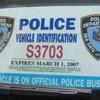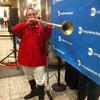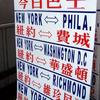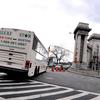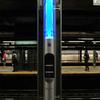Jim O'Grady appears in the following:
More Than Half of City Parking Placards Are Bogus, Improperly Used: Report Claims
Tuesday, April 26, 2011

A new report claims the city's system of cracking down on counterfeit and improperly used parking placards "remains broken."
After OTB Closes, Fans Head to the Track
Tuesday, April 26, 2011

The shuttering of New York State's Off-Track Betting parlors last year seemed to initially deal a blow to the thoroughbred racing industry — but their closing may now mean fans are off to the races instead.
Amtrak: Our Discount Bus-Level Fares Have Nothing To Do With Discount Buses
Thursday, April 21, 2011
This pro-train ad is not meant to imply competition with other modes of long-distance travel.
(New York, NY - Jim O'Grady, WNYC) Amtrak is in the midst of a three-day sale for northeast corridor travel. No big deal, according to Amtrak spokesman Cliff Coles, who said the railroad has been holding such sales for a year now. But what caught our eye were the Chinatown Bus-like prices: $29 for Washington, D.C., or Baltimore to New York; $19 for Washington, D.C., to Richmond, Virginia . The fares are valid for travel from May 10 to May 26.
That raises the obvious question of whether Amtrak is responding to competitive pressure from inter-city buses, which a DePaul University study says grew by six percent nationwide in 2010. Perhaps now is the time for Amtrak to make a savvy push to snag customers rattled by a string of deadly crashes that raise safety concerns about curbside buses.
Officially, none of that has anything to do with the low fare offer. "I don’t know that there’s anyone we’re competing against," said Coles. He added that Amtrak ridership nationwide in the last six months was up by four percent--as in, one-third less than the growth of inter-city buses. Coles did not have numbers for the northeast corridor.
We Can't Afford Streetcars in Red Hook, City Says
Wednesday, April 20, 2011

The city Department of Transportation has made it official: putting streetcars in Red Hook, Brooklyn, would cost too much to justify small gains in ridership over the existing B61 bus.
Even A Guy Who Writes About Road Repair Can Win A Pulitzer
Tuesday, April 19, 2011
(New York, NY - Jim O'Grady, WNYC). New York Times economics columnist David Leonhardt, an acquaintance, won a Pulitzer Prize yesterday for commentary. That's good for me because it's satisfying to see a guy whose work you admire--and to whom you once threw a touchdown pass in Prospect Park--rewarded with a prize everyone has heard of.
It's also good for the larger discussion about government's role in the economy, to which Leonhardt contributes with unusual integrity and clarity. For example, here is his recent blog post on the debate about how a Federal Highway Bank could help shift governments from building new roads, some of them unnecessary, to repairing existing ones.
It's a geeky topic, which is OK by Transportation Nation. Leonhardt handles it with typical aplomb.
![]() Follow Transportation Nation on Twitter.
Follow Transportation Nation on Twitter.
NYC DOT Poised to Nix Streetcar Plan in Brooklyn
Tuesday, April 19, 2011
An old New York streetcar at rest on the Red Hook waterfront. (Photo by nickherber / Flickr Creative Commons)
(New York, NY -- Jim O'Grady, WNYC) The New York City Department of Transportation says it won't support a proposed light rail line in the Red Hook neighborhood of Brooklyn because it's not worth the cost.
Mayor Michael Bloomberg promised to pilot a streetcar line along the Brooklyn or Queens waterfront during his 2009 re-election campaign. One possible location was a Red Hook line connecting the transit-starved neighborhood to subways in Downtown Brooklyn and nearby Carroll Gardens.
But a summary of the NYC DOT's study says the line would cost $176 million to build, and nearly $7 million a year to keep going. It also argues streetcars would attract only 12 percent more riders than a local bus route already carries. That's because the study assumes that with Red Hook car ownership rates barely breaking 20 percent, most people take mass transit already.
Mayoral spokesman Stu Loeser said other plans for light rail have been put on hold because of expected cuts in federal and state transportation aid.
Residents in favor of a streetcar line say it would be more durable and reliable than the bus. The department's findings come from a summary given to neighborhood groups. The full report is due out on Wednesday.
Read more on the report here.
![]() Follow Transportation Nation on Twitter.
Follow Transportation Nation on Twitter.
Lost And Unused Metrocards Add Up To $52 Million A Year in NYC
Monday, April 18, 2011
(Photo by: Darny / Flickr creative commons)
(New York, NY - Jim O'Grady, WNYC) New Yorkers, have you ever lost a metrocard for months at the bottom of your purse or in between the couch cushions? Or maybe you still have one that would be worth ten dollars if you hadn't let it expire? Well, add those to everyone else's lost or unused Metrocards over a year and the total comes to $52 million.
In practical terms, riders' absentmindedness helps the NYC MTA. Say your cousin from Louisville leaves town with a pay-per-ride card with eight dollars on it: that's a service purchased that the NYC MTA needn't provide. But that money--all $52 million--could potentially be cashed in by riders. So it sits on the NYC MTA's books as a liability.
Follow Transportation Nation on Twitter
Lost And Unused Metrocards Add Up To $52 Million a Year
Monday, April 18, 2011

The value of lost, expired or unused Metrocards over the course of a year adds up to a hefty $52 million. To encourage riders to keep better track of cards, the MTA will start charging a $1 Metrocard replacement fee later this year.
Feds Say Tour Bus Was Speeding Before Fatal Bronx Crash
Friday, April 15, 2011
 (New York, NY -- Jim O'Grady, WNYC) A report by federal investigators says a tour bus that crashed on Interstate 95 in the Bronx last month was speeding at 78 miles per hour shortly before it struck a highway signpost, killing fifteen passengers. The bus was returning to New York on a pre-dawn trip from a Connecticut Casino.
(New York, NY -- Jim O'Grady, WNYC) A report by federal investigators says a tour bus that crashed on Interstate 95 in the Bronx last month was speeding at 78 miles per hour shortly before it struck a highway signpost, killing fifteen passengers. The bus was returning to New York on a pre-dawn trip from a Connecticut Casino.
Driver Ophadell Williams said the March 12 accident began when a tractor trailer truck cut him off and struck the bus. But investigators say they found no evidence of an impact between the bus and another vehicle. And sensors on the bus' engine show it was moving at top speed down a southbound lane of the Hutchinson River Parkway only 45 seconds before impact.
Listen to an interview on this with Transportation Nation's Alex Goldmark.
According to the report, the bus swerved to the right off the highway, crossed an eleven-foot wide shoulder and smashed into a three-foot-tall steel guardrail. The bus plowed through the guardrail for 480 feet as it toppled onto its side. The bus' windshield hit the post of a massive highway sign, which sheared the bus in two along the base of the passenger windows almost all the way to the rear. The bus came to rest on top of the crushed guardrail, its wheels in the air, facing the highway.
Budget Bus in Fatal Bronx Crash Was Speeding, Feds Find
Friday, April 15, 2011

The budget bus that crashed on I-95 in the Bronx killing 15 passengers last month was speeding at 78 miles per hour moments before the tragic accident, a report by federal investigators revealed.
Pedestrian Countdown Clocks Placed At Dangerous NYC Intersections
Monday, April 11, 2011
New pedestrian countdown clock in Brooklyn.
(New York, NY -- Jim O'Grady, WNYC) Pedestrians have forty-three new countdown clocks at some of New York City 's most dangerous intersections to tell them how much time there is left to cross the street. When the LED crosswalk signals show a flashing red hand, they also start displaying the dwindling seconds left until vehicles regain the right of way and may zoom past again.
City officials held a press conference announcing the new lights at the intersection of Flatbush Avenue and Fulton Street in Brooklyn, where six streets cross.
"Individuals should not have to take their life into their hands when they cross Flatbush Avenue," said City Councilwoman Letitia James, who represents the area. "These countdown clocks will go a long way in improving safety and reducing pedestrian fatalities and cyclist fatalities in the city of New York."
The current crop of clocks is installed at dangerous intersections on major thoroughfares like Queens Boulevard, the Grand Concourse in the Bronx and Hylan Boulevard in Staten Island. Department of Transportation Commissioner Janette Sadik-Khan said at the press conference that a 2010 department study showed "major corridors are two-thirds more deadly for pedestrians” than smaller roads.
Former National Safety Board Chief Rips Bus Industry
Monday, April 11, 2011
 (New York, NY -- Jim O'Grady, WNYC) When three inter-city buses crashed in the northeast last month, killing 17 people and injuring dozens of others, public officials and many in the booming industry itself said the time had come for reform. The debate is over what kind of regulations to impose on the sprawling industry, which makes 750 million passenger trips a year and accounts for more than 2,000 arrivals and departures every week in New York City.
(New York, NY -- Jim O'Grady, WNYC) When three inter-city buses crashed in the northeast last month, killing 17 people and injuring dozens of others, public officials and many in the booming industry itself said the time had come for reform. The debate is over what kind of regulations to impose on the sprawling industry, which makes 750 million passenger trips a year and accounts for more than 2,000 arrivals and departures every week in New York City.
Among those calling for stricter regulation is James Hall, chairman of the National Transportation Safety Board from 1984 to 2001, who in an interview with Transportation Nation criticized long distance bus companies for placing profits over safety, and government for letting it happen.
“We haven’t seen a commitment by the industry or the government," Hall said. "They have treated the people who ride these buses as second-class citizens and given them second class safety.”
He said the 2009 crash of a commuter airline in Buffalo, which killed 50 people, led to tighter regulation of short-hop air carriers; but fatal bus accidents have left bus operators relatively untouched by stricter safety rules.
"I'd like to see the federal government take the responsibility for the safe transportation of citizens on motorcoaches just as seriously as they take the safe transportation of more affluent citizens on commercial aviation," he said.
Hall said he's familiar with the rise and fall of official ire in the months after deadly bus crashes. Federal lawmakers, who have authority over interstate travel, express grave concern. They sometimes even take the next step and author a serious set of recommendations, such as the U.S. Department of Transportation's 2009 Motor Coach Safety Action Plan.That report inspired The Motorcoach Enhanced Safety Act, which would've mandated safety upgrades like seat belts, stronger windows and fire suppression equipment on long distance buses.
The American Bus Association, a trade group based in Washington, DC, largely opposed the measure. It estimated the cost of the regulations for new buses at as much as $89,000 per vehicle. A typical new motor coach costs about $500,000. The bill failed.
Association president Peter Pantuso said he supported training bus drivers to a national standard. But he's concerned that mandatory safety features could drive up fares. And low fares are what keep bus operators in business, especially in the burgeoning discount sector.
"The industry is really made up of a lot of very, very small mom and pop companies who operate very safely," he said. "And there are a lot of regulations already in place. It’s a matter of enforcement."
Hall was not satisfied with that sentiment. “I have yet to see the American Bus Association be aggressive on the subject of safety," he said. "They’re aggressive in regard to insuring the profits of their own membership but they need to be just as aggressive in policing their own industry.”
Congress is poised to weigh in with two separate bus safety bills, both of which call for training drivers to a national standard and conducting stricter checks on them. They differ as to how much safety equipment upgrades should be imposed.
And soon the NTSB will release the results of its investigation into the March 12 crash in the Bronx that killed 15 people. The NTSB will also be examining the effectiveness of the Federal Motor Carrier Safety Administration, the agency charged with regulatory enforcement of the tour bus industry and which has been criticized for lax oversight.
Pantuso said his association is all for rigorous enforcement of existing rules on driver rest and fitness, and inspections of vehicles. But he's wary of over-regulation. He says despite recent crashes, taking a long-distance bus is one of the safest modes of travel in North America--and that should count for something.
Philip White is a bus driver who earns $320 for driving round-trip in two days from New York to Richmond, VA--a five and a half to seven hour trip each way, depending on traffic. He works for Apex Bus, a company based in Manhattan's Chinatown. He recently leaned on the steering wheel in his bus and considered what's at stake when it comes to bus safety.
“Everybody on this bus has a wife or husband and kids," he said. "Or a mother and father at least. It’s not a joke.”
Listen to WNYC FM this morning to hear Hall's remarks.
Debate Over Budget Bus Regulation Continues in Wake of Tragic Crashes
Saturday, April 09, 2011

In the wake of three recent budget bus crashes in the northeast — killing 17 and injuring dozens of others — officials are now wrangling over what kind of regulations to impose on the sprawling industry, which makes 750 million passenger trips a year and accounts for more than 2,000 arrivals and departures every week in New York City.
$38.5 M to NJ Bridge Upgrade Needed for High-Speed Rail
Saturday, April 09, 2011
 (New York -- Jim O'Grady, WNYC) New Jersey Senators Frank Lautenberg and Robert Menendez just sent out a press release announcing federal funds to replace a balky rail bridge that commonly causes delays for Amtrak and New Jersey Transit trains. The upgrade is considered crucial to bringing the next generation of high-speed rail to the northeast corridor. A new bridge at the site is also integral to plans for the Gateway Project, a proposed two-track rail tunnel under the Hudson. The release, which contains one of Senator Lautenberg's patented references to unnamed Republican operatives out to thwart him, is below.
(New York -- Jim O'Grady, WNYC) New Jersey Senators Frank Lautenberg and Robert Menendez just sent out a press release announcing federal funds to replace a balky rail bridge that commonly causes delays for Amtrak and New Jersey Transit trains. The upgrade is considered crucial to bringing the next generation of high-speed rail to the northeast corridor. A new bridge at the site is also integral to plans for the Gateway Project, a proposed two-track rail tunnel under the Hudson. The release, which contains one of Senator Lautenberg's patented references to unnamed Republican operatives out to thwart him, is below.
Federal Recovery Act Funding Secured for Critical Infrastructure Project
WASHINGTON, D.C. — U.S. Senators Frank R. Lautenberg (D-NJ) and Robert Menendez (D-NJ) today announced that New Jersey Transit will be awarded $38.5 million through the American Recovery and Reinvestment Act (ARRA) to begin replacing the 100-year old Portal Bridge that crosses the Hackensack River between Kearny and Secaucus. With the funding now being provided by the U.S. Department of Transportation (DOT), work could begin shortly.
“The Portal Bridge is a major chokepoint for thousands of commuters every day and an obstacle in the way of our efforts to improve regional rail transportation,” stated said Lautenberg, who as a member of the Senate Appropriations Committee helped write the Recovery Act. “This federal funding will help replace the bridge so that train riders have a shorter, safer and more reliable commute every day. Replacing the bridge will also prepare our regional infrastructure for new high-speed rail opportunities that will improve the economy and get cars off the road. I am pleased to see the Recovery Act again deliver funding for a New Jersey project that will create jobs and benefit our state. This funding is a good start on a great project and I will continue fighting against Republican attempts to shortchange infrastructure projects like the Portal Bridge.”
Many Still Get Parking Placards Despite Talk of Reform
Friday, April 08, 2011

Despite calls for reform, many state employees still get "free parking" cards.
NY State Parking Placard Reform: A Closer Look
Friday, April 08, 2011
 (New York, NY - Jim O'Grady, WNYC) Many state employees still get "free parking" cards.
(New York, NY - Jim O'Grady, WNYC) Many state employees still get "free parking" cards.
When New York State Inspector General Ellen Biben announced yesterday that the state's police parking placard policy was so slipshod it "invited abuse," she immediately followed with two numbers meant to convey an air of stern reform. She said the number of police placards had been cut from 1,730 to 261--an 84 percent reduction. But that doesn't mean the total number of placards has been cut by that much.
cut by that much.
Many users have been shifted to "official business" placards, which are more restrictive than police placards that say "this vehicle is on official police business." The "official business" placards allow users to park in commercial zones, spots near some government offices and, let's be honest, where they can get away with it. Though the total number of placards has been reduced by ten percent, there are still nearly 2,000 of them in circulation.
The state has 3,500 placards at its disposal, according to the Office of Court Administration, which has in the past overseen production of the placards for reasons lost to history. Biben said the executive branch had previously issued 2,210 of them. After the inspector general's review of users, there are now a total of 1,993 placards in circulation. Officials say that number is necessary because state employees, such as food inspectors, need the placards to drive to multiple locations to do their jobs.
Giving out a mere 217 more placards would get the state back to its pre-crackdown number, though most of them would be "official business" rather than police placards.
Advocates like Transportation Alternatives have called for big reductions in the use of parking placards, because they say, easy parking encourages people to drive more -- at a time when governors and mayors are encouraging people to use transit, bike, walk, or carpool to relieve congestion and reduce carbon emissions. After a brouhaha a couple of years ago about the loose distribution of placards to New York City employees, Mayor Bloomberg said he'd reduce the number from 140,000 to something less than half of that.
Biben said the real innovation is that each new state-issued placard has an ID number tying it to the user's license plate number.That should reduce the practice of passing them around. Each placard also shows the name of the agency for whom the bearer works. For example, a restaurant inspector's placard would say "Board of Health."
The new placards have a one-year expiration date, which presumably means an annual review of whether the user really needs it to do his job. And a government employee must now apply for a placard--which was not the case before, when the privilege was handed out to friends and family of the politically connected. Employees must now also sign an agreement saying they will only use it on government business. If a worker gets caught using a placard on personal business or in violation of other guidelines, he or she could face civil and criminal penalties.
The Governor's Director of State Operations Howard Glaser, who was at the press conference with Biben, said he's counting on the public to report misuse of the privilege, though he didn't say how besides calling the inspector general's office. When asked if he'd list placard bearers online by agency and job title, he said he'd "look into it."
Transportation Alternatives says the best way to insure proper use of the placards would be to stamp each one with a bar code that could be scanned by traffic enforcement agents.
Gov Cuomo's Office Announces Tightened Rules on Parking Placards
Friday, April 08, 2011
(New York, NY - Jim O'Grady, WNYC) Governor Cuomo's Director of State Operations Howard Glaser said that from now on the state will use a new method to distribute parking placards to its employees. The old way, he said, was to hand them out "like candy" to friends and family of the politically connected. The new way, he said, will be to keep track of every employee who has one and how he or she is using it.
The changes come after an investigation by New York State Inspector General Ellen Biben found widespread distribution of police parking placards to government employees who had no police business to conduct.
"It was a system that had no clear guidelines governing the appropriate uses of the placards, which made enforcement of the abuses nearly impossible," Biben said. "Quite simply, it was a system that invited abuse."
She said a crackdown on the distribution of police parking placards to state employees has reduced their number by eighty-four percent. But thanks to a new "official business" type of placard, which more than 1,000 employees have qualified for, the overall number of state parking placards has dropped by only ten percent.
Glaser said the real advance is that every state parking placard now has an ID that can be tracked back to its user, making it easier to report and investigate misuses of the privilege.
Government workers must now be approved by the state police or the Governor's Office of Public Safety before they can get a parking placard. Applicants must also sign an agreement saying they will only use the placard on government business. If a government worker is found to be misusing a placard, he could face both civil and criminal penalties.
Glaser said the ID number on every placard will empower the public to turn in suspected placard abusers. "What you will be able to do is to look at the number on a placard and if you believe that the parking is inappropriate, that can be reported to local law enforcement or to the state police," he said. A report can also be made through the complaint page on the Inspector General's website.
![]() Follow Transportation Nation on Twitter.
Follow Transportation Nation on Twitter.
Sleek New Subway Intercom Kiosks Installed on Trial Basis
Tuesday, April 05, 2011

New York City subway riders can now use intercom kiosks at two subway stops to communicate with MTA personnel in emergencies or for information.
NYC MTA Installs New Subway Emergency Thingies
Tuesday, April 05, 2011
MTA New York City Transit's new Help Point subway communications system (Photo by: NYC MTA.)
(New York, NY - Jim O'Grady, WNYC) When the NYC Metropolitan Authority balanced its books in part last year by laying off 450 token booth clerks, riders wondered who they'd turn to in an emergency. Today came the authority's second try at answering that question.
Riders can now use intercom kiosks on two subway platforms to talk to NYC MTA staff. The devices are tall, attached to columns and glow blue. Riders can push a red emergency button to speak to the subway's Rail Command Center. Staff there, which works around the clock and includes police officers, can locate the rider by caller ID and dispatch police to the scene.
Speaking on a 6 train platform at 23rd street, NYC MTA Chairman Jay Walder said the devices--called Help Point-- are being tested at two subway stations on the Lexington Avenue line.
"It is the use of technology to make our customers more comfortable and feel more secure in our subway system," he said.
The kiosks also have a green information button connecting riders to the station's token booth clerk. The NYC MTA maintains there is still at least one token booth clerk at each of its 468 stations at all times.
Help Point replaces a previous generation of customer assistance devices that proved problematic. The older devices did not have digital audio, which sometimes made it hard to hear and be heard. They also had an indistinct design that made them blend with their surroundings--few riders knew where they were or what to do with them.
If the Help Point program is successful, the NYC MTA will consider expanding the kiosks to other subway stations, but wouldn't commit to a time line. Walder said it would cost an average of $300,000 per station to install Help Point systemwide. It would take more than 5,000 of the devices to meet the NYC MTA's goal of having one every 150 feet on platforms.
Riders have expressed concern about safety since the MTA laid off the token booth clerks last year.
![]() Follow Transportation Nation on Twitter.
Follow Transportation Nation on Twitter.
US DOT Orders Safety Review After 22 Workers Die in Pipeline Explosions in 2010
Monday, April 04, 2011
This in today:
U.S. TRANSPORTATION SECRETARY RAY LAHOOD ANNOUNCES PIPELINE SAFETY ACTION PLAN
U.S. Transportation Secretary Ray LaHood today launched a national pipeline safety initiative to repair and replace aging pipelines to prevent potentially catastrophic incidents.
Following several fatal pipeline accidents, including one that killed five people in Allentown, PA, Secretary LaHood called upon U.S. pipeline owners and operators to conduct a comprehensive review of their oil and gas pipelines to identify areas of high risk and accelerate critical repair and replacement work. Secretary LaHood also announced federal legislation aimed at strengthening oversight on pipeline safety, as well as plans to convene a Pipeline Safety Forum on April 18th in Washington, DC, to gather state officials, industry leaders, and other pipeline safety stakeholders in order to discuss steps for improving the safety and efficiency of the nation’s pipeline infrastructure.
![]() Follow Transportation Nation on Twitter.
Follow Transportation Nation on Twitter.
“People deserve to know that they can turn on the lights, the heat, or the stove without endangering their families and neighbors,” said Secretary LaHood. “The safety of the American public is my top priority and I am taking on this critical issue to avoid future tragedies we have seen in Allentown and around the country.”
